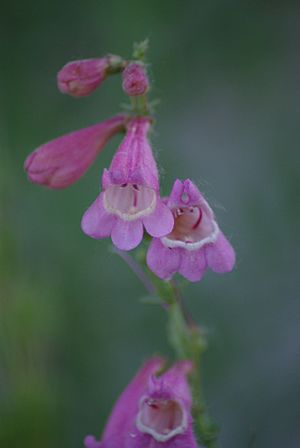Sunset Crater beardtongue facts for kids
Quick facts for kids Sunset Crater beardtongue |
|
|---|---|
 |
|
| Conservation status | |
| Scientific classification |
The Penstemon clutei, also called the Sunset Crater beardtongue, is a beautiful flowering plant. It belongs to the plantain family. This special plant grows only in Arizona. You can find it around volcanic cinder cones, like Sunset Crater, in Coconino County. This means it is "endemic" to that area, which means it naturally lives only there.
Contents
About the Sunset Crater Beardtongue
What Does It Look Like?
The Sunset Crater beardtongue is a perennial plant. This means it lives for more than two years. It can grow up to 80 centimeters (about 31 inches) tall. Its leaves are waxy and have jagged edges, like a saw.
This plant blooms with pretty pink flowers. These flowers are shaped like tubes. You can see them blooming from April all the way through August.
Where Does It Grow?
This plant is very picky about where it lives! It only grows on the volcanic fields. These fields are found around Sunset Crater in Coconino County, Arizona.
It likes to grow in open spaces. You can also find it near Ponderosa pines. These are large pine trees.
Why Is It Special?
The Sunset Crater beardtongue is a "fire-adapted" species. This means it can survive and even do well after a wildfire. Fire is a natural part of its environment.
Protecting This Plant
Even though it's tough, this plant faces some challenges. One problem is off-road vehicles. When vehicles drive off marked roads, they can damage the plants and their habitat.
Another challenge is "hybridization." This happens when the Penstemon clutei mixes with other types of Penstemon plants. This can make it harder for the pure Penstemon clutei to survive. Scientists work to protect this unique plant.
How It Got Its Name
The plant was first described in 1927. A scientist named Aven Nelson called it a subspecies of another plant, Penstemon pseudospectabilis.
Later, in 1937, another scientist named David D. Keck gave it its own species name. He did this because the plant grows only in a very specific place. This unique habitat showed it was a distinct species.


